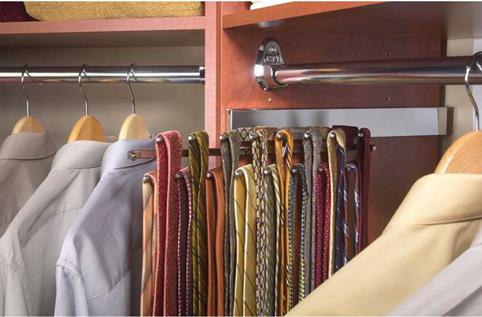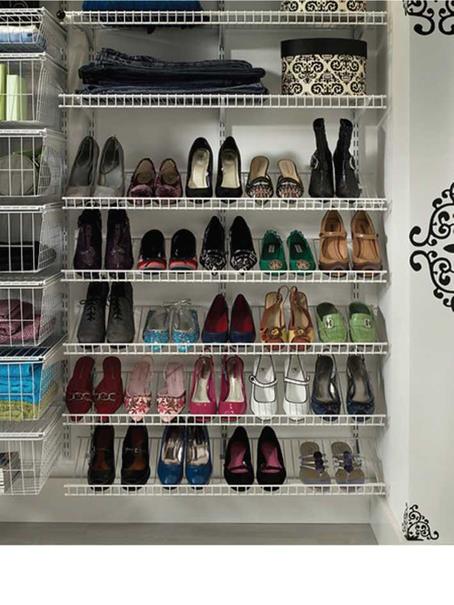Closet layouts are often described in three different ways, based on the clearance for access to the hangers: reach-in, edge-in, and walk-in. Figure 9.5 shows examples of these closet layouts. The dimensions shown are minimum access space. However, these minimums are very tight, and more generous clearances are recommended. For example, although a 24-inch (610 mm) opening is shown as the minimum, an opening of 60 inches (1524 mm) to 72 inches (1823 mm) is desirable for a clear view of, and access to, a closet. For a roll-in closet, include a 60-inch (1524 mm) diameter clear space, which can extend 12 inches (305 mm) under one side, or 6 inches (152 mm) on both sides, of the hanging clothes (Figure 9.5d).
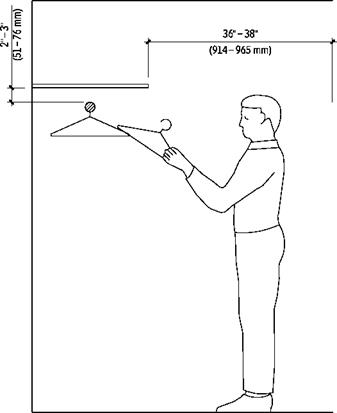

Other Types of Closet Storage
A clothes closet can hold much more than hanging clothes. A well-designed clothes storage area can include shelves, drawers, hooks, bins, and other devices for storing clothes, shoes, and accessories. The inventory checklist, Form 12: Clothes Storage Inventory for Folded, Rolled, and Other Types of Clothes, collects information about the number of other clothing items to be stored, as well as your client’s preferred type of storage.
Shelf and Drawer Space. How much shelf and drawer space is needed? That can be a hard question to answer, depending on what items a person has to store in the closet, how they are
![]()
|
|
f———————- ACCESSIBLE ROD LENGTH————————————— * |
|
|
|
|
|
|
|
|
|
|
|
|
|
|
|
|
|
|
|
|
|
|
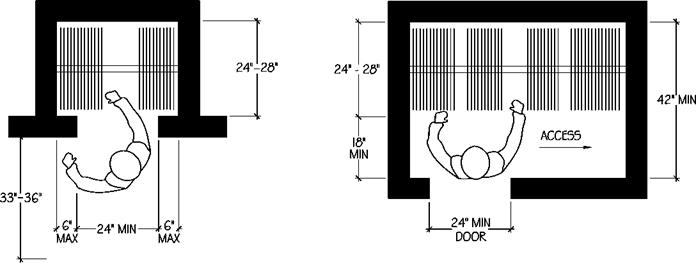
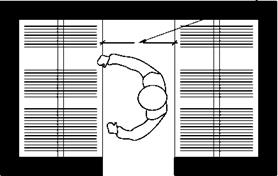
![]()
![]()
![]()
![]()
![]()
FIGURE 9.5 Minimum dimensions are shown for different closet layouts, but more generous clearances are recommended, (A) is a reach-in closet. (B) is an edge-in closet. (C) is a walk-in closet. (D) is an alternative design for a walk-in closet, which has been adapted to work as a roll-in closet.
NKBA
folded or rolled, and how they are stacked. Recommendations vary from 8 square feet (0.74square meters) to 20 square feet (1.86 square meters) of space per person. These recommendations assume a typical drawer depth or shelf clearance of at least 6 inches (152 mm).
For a custom installation, you may want to count the number of garments and the amount of space they will need. Use Form 12: Clothes Storage Inventory for Folded, Rolled, and Other Types of Clothes, to get a complete inventory of the items to be stored on shelves or drawers. Discuss with your client how things will be organized. What items will be stored together? Then take some sample measurements of the amount of space the stored items require.
Form 13: Worksheet for Folded or Rolled Clothing can be used to determine how much drawer and shelf space is needed. Using the worksheet, you can determine the size of the various stacks of garments, which can then be grouped into requirements for drawer and shelf space. Be sure to allow room for expansion!
Form 13: Worksheet for Folded or Rolled Clothing
Use the information from Form 12: Clothes Storage Inventory for Folded, Rolled and Other Types of Clothes to determine the number of garments. The number per stack is typically two to six items, depending on the number of garments and client preference. Determine the size of each stack. This information is then used to determine the total amount of shelf and/or drawer space that is needed.
|
Items Stored in Drawers |
||||||
|
✓ |
Garment |
Number of garments |
Number per stack |
Dimensions in Inches, per Stack |
||
|
Frontage |
Depth |
Stack Height |
||||
|
Example: |
||||||
|
T-shirts |
18 |
6 |
12 |
16 |
5 |
|
(continued)
|
Items Stored on Shelves |
||||||
|
✓ |
Garment |
Number of garments |
Number per stack |
Dimensions in Inches, per Stack |
||
|
Frontage |
Depth |
Stack Height |
||||
|
Example: |
||||||
|
T-shirts |
18 |
6 |
12 |
16 |
5 |
|
Access and Clearance Space. When shelves or drawers are added to a closet, there needs to be adequate space for access. There are several concerns:
• Maximum reach to upper shelves (see Figure 9.6).
• Bending or kneeling space to reach lower shelves (see Figure 9.7).
• Depth of an open drawer added to bending or kneeling space (see Figure 9.8).
To accommodate clients who are shorter or who use a mobility aid, lower the storage reach to 48 inches (1219 mm), particularly for items used regularly, and increase the clear floor space. Alternatively, refer to the Reach and Grasp Profile and Mobility Aids information that is part of Form 1: Getting to Know Your Client which is discussed in Chapter 5, "Assessing Needs."
Hooks. Hooks work well to store frequently used items such as nightgowns, pajamas, robes, or belts. They also work well for items that are awkward to fold, such as scarves or ties. Put hooks within easy reach, but not in a passageway or other location where someone might bump into them. A minimum height for a hook is the length of the garment or item to store, plus 6 inches (152 mm) of clearance beneath. Space multiple hooks 3 to 12 inches (76 to 305 mm) apart, depending on the bulkiness of the items to be stored.
More Than Clothes?
A well-designed closet with plenty of rod, shelf, drawer, and hook storage may be just the beginning for your client. There may be other items or activities to be accommodated in the clothes storage and/or dressing area.
FIGURE 9.6 The typical maximum reach for a 12-inch (305 mm) shelf is illustrated here. A deeper shelf or obstruction (such as hanging clothes) will decrease the maximum shelf height.
![]()
![]()
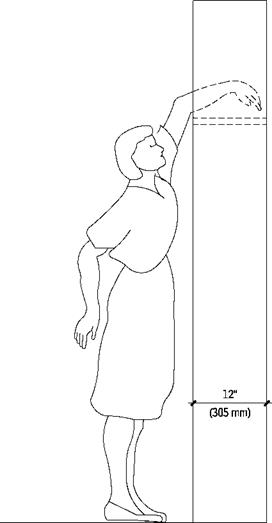
![]()
![]() NKBA
NKBA
|
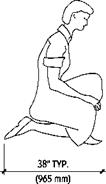
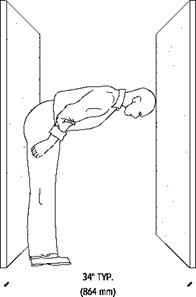
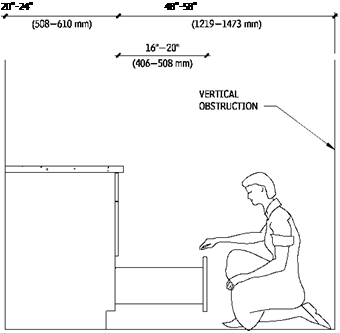 FIGURE 9.8 Bending or kneeling at an angle to the drawer will reduce the space needed for drawer access, but larger or deeper drawers will require more space.
FIGURE 9.8 Bending or kneeling at an angle to the drawer will reduce the space needed for drawer access, but larger or deeper drawers will require more space.
NKBA
Does your client have a dresser, chest of drawers, armoire, or other piece of furniture that they would like to move into the closet area? Putting clothes storage furniture into the closet/dressing area can free up floor space in the bedroom and centralize clothes storage into one area. Measure the piece of furniture to know how much space will be needed. Allow for access to furniture pieces, just as for built-in storage.
A clothes storage area can also become a clothes care and maintenance area. Laundry areas as part of the bathroom are discussed later in this chapter. A closet may be the preferred area for a clothes hamper or a laundry chute. Perhaps an ironing or pressing area would be desirable (see Figure 9.9). A space for a sewing machine or mending supplies would be another extra feature.
|
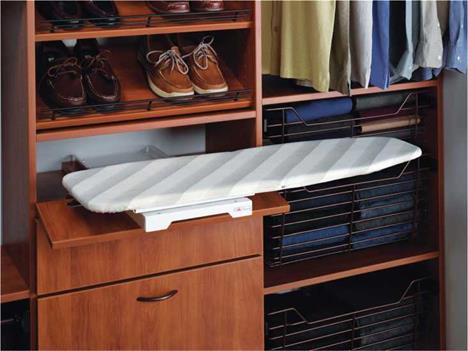
|
